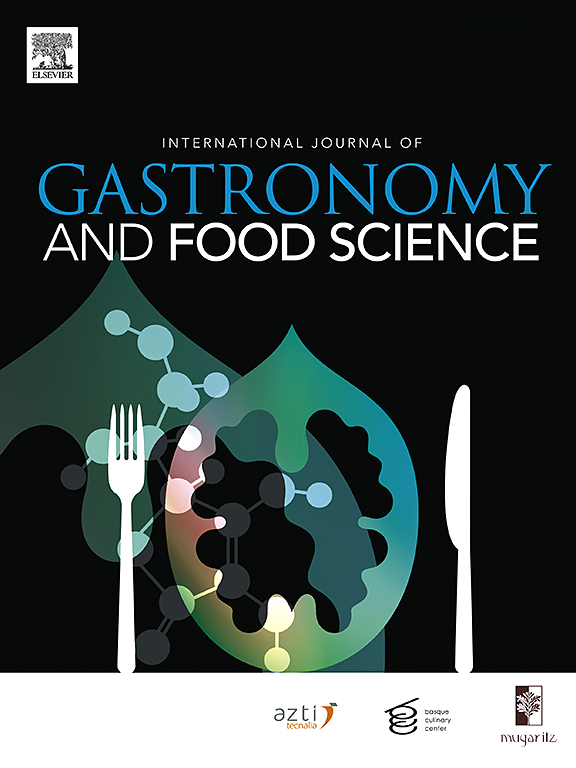西班牙和意大利消费者对干腌火腿的偏好:大理石纹、猪的性别和去势方式的影响
IF 3.2
2区 农林科学
Q2 FOOD SCIENCE & TECHNOLOGY
International Journal of Gastronomy and Food Science
Pub Date : 2025-04-22
DOI:10.1016/j.ijgfs.2025.101187
引用次数: 0
摘要
干腌火腿要么来自手术阉割的雄性(以避免公猪的污染),要么来自完整的雌性,但已经提出了免疫阉割方法来改善雄性的动物福利和雌性的大理石纹。一项消费者细分研究(涉及西班牙和意大利的4200名参与者)通过在线问卷进行,其中包括一项选择实验,其中盲选和知情选择来自手术阉割或免疫阉割的男性(通过疫苗接种)和来自完整或免疫阉割的女性。在男性免疫阉割的情况下,对“瘦肉爱好者”(“瘦肉爱好者”)的偏好表现为:没有孩子的年轻人,旅行较少,很少参与家务,较少食用火腿,对养猪生产系统了解较少,对内在和外在购买线索的评分较低,与性别和国家无关。尽管阉割方法标签是由整个消费者声称的,那些重视脂肪含量的人(“大理石纹爱好者”)对阉割方法信息的效用排名更高,并表现出更高的意愿为男性和女性的免疫阉割付费。本文章由计算机程序翻译,如有差异,请以英文原文为准。
Consumer preferences for dry-cured ham in Spain and Italy: Impact of marbling, sex and castration methods of pigs
Dry-cured hams come from either surgically castrated males (to avoid boar taint) or from intact females, but immunocastration method has been proposed to improve animal welfare in males and marbling in females. A consumer segmentation study (involving 4200 participants in Spain and Italy) was conducted through an online questionnaire including a choice experiment with blind and informed options of hams from surgically castrated- or immunocastrated-males (by vaccination), and from intact- or immunocastrated-females. The preference for a lean appeal (‘lean lovers’), complying with immunocastration of males, was shown by: young people, without children, travelling less, scarcely involved in home-tasks, consuming less frequently ham, having less knowledge about pig production system, and grading less the intrinsic and extrinsic purchasing cues, independently of gender and country. Even though castration method label is claimed by whole consumers, those valuing fat content (‘marbling lovers’) rank higher the utility of information regarding castration methods and show higher willingness to pay for immunocastration of males and females.
求助全文
通过发布文献求助,成功后即可免费获取论文全文。
去求助
来源期刊

International Journal of Gastronomy and Food Science
Social Sciences-Cultural Studies
CiteScore
5.30
自引率
10.50%
发文量
170
审稿时长
45 days
期刊介绍:
International Journal of Gastronomy and Food Science is a peer-reviewed journal that explicitly focuses on the interface of food science and gastronomy. Articles focusing only on food science will not be considered. This journal equally encourages both scientists and chefs to publish original scientific papers, review articles and original culinary works. We seek articles with clear evidence of this interaction. From a scientific perspective, this publication aims to become the home for research from the whole community of food science and gastronomy.
IJGFS explores all aspects related to the growing field of the interaction of gastronomy and food science, in areas such as food chemistry, food technology and culinary techniques, food microbiology, genetics, sensory science, neuroscience, psychology, culinary concepts, culinary trends, and gastronomic experience (all the elements that contribute to the appreciation and enjoyment of the meal. Also relevant is research on science-based educational programs in gastronomy, anthropology, gastronomic history and food sociology. All these areas of knowledge are crucial to gastronomy, as they contribute to a better understanding of this broad term and its practical implications for science and society.
 求助内容:
求助内容: 应助结果提醒方式:
应助结果提醒方式:


